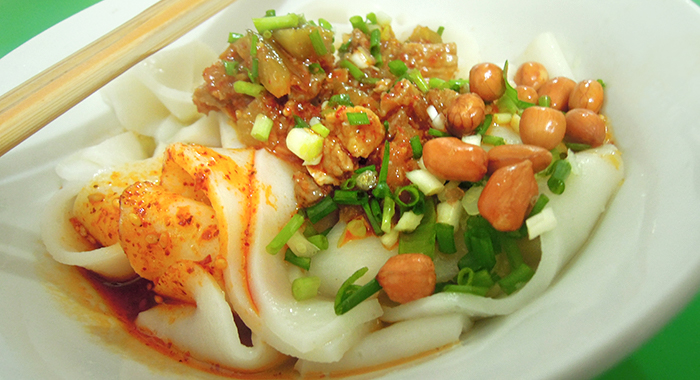Fiery Feasting With the Street Food of Zunyi
Frank (Kaszar) Kasell ’06 quit his job and spent three months researching a book on Chinese street food. Then he came home and wrote “Chinese Street Food: a Field Guide for the Adventurous Diner.” Kasell’s story is among those told in Out-of-Office Message, our feature on working far – far! – from home. Even if a gig like that feels like a pipe dream to some, readers can still enjoy Kasell’s descriptions of the food he encountered – descriptions to feed the soul of even the armchair traveler!
This excerpt, reprinted here with kind permission, focuses on the city of Zunyi in Guizhou Province.
鸭溪凉粉
Yāxī Liáng Fĕn
Cost: 5 RMB
This variation on liáng fĕn – one of many in China – originates in a town about 50 km outside of Zunyi. Like all liáng fĕn, the recipe for this dish begins with a starchy paste (here made of dried peas) that is left to congeal into a firm, jelly-like substance. All liáng fĕn is also sliced to resemble noodles, though most don’t do a great job at disguising themselves. Here in Zunyi we have an exception – if you didn’t know this was liáng fĕn, you would have no idea that it wasn’t a bowl of rice noodles. The starchy bone-white pea paste is sliced into long, thin strips that wend their way hither and thither in your bowl. On top of the pseudo-noodles you will find fried soybeans, a sprinkling of green onion, and a mildly spicy chili-vinegar sauce. The “liáng” in liáng fĕn means “cool,” which is precisely how the noodles are served. The coolness is a lovely contrast with the heat emanating from the chili sauce, resulting in a refreshing dish appropriate for cold and hot weather alike. This unassuming little bowl of pea starch noodles is a great variation on a common Chinese street food and is worth seeking out when you’re in Zunyi.
Key words: pea noodles, cool, chili sauce, soybeans
臭豆腐
Chòu Dòu Fu
Cost: 4 RMB 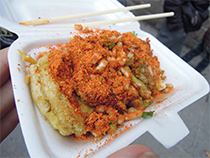 Ah, stinky tofu: often one of the most instantly recognizable street foods in China. So recognizable that you don’t even need to see it to identify it. Several cities’ versions of the dish (especially Changsha’s and Shaoxing’s) are famous throughout the country. How does Zunyi’s take measure up? Admirably! The star ingredient is, of course, the stinky tofu itself, which gets its name from the smell of fermentation. It comes fried and cut into slabs about the size of a deck of cards. The yellow-brown skin contains a grayish white interior with an almost custardy texture. To be frank, the stinky tofu in Zunyi is not all that stinky. It has a stronger taste than unfermented tofu, to be sure, but it doesn’t have that punch-you-in-the-face odor so notable in other stinky tofu. What makes Zunyi’s stinky tofu really stand out is the mound of chili powder and zhé ĕr gēn sitting on top of the tofu slabs. Together these toppings add a powerful kick, equal parts spicy and herbal; this combination of flavors is completely unique to the region. You may be able to get stinkier tofu elsewhere in the country, but only in Guizhou will you find stinky tofu like this.
Ah, stinky tofu: often one of the most instantly recognizable street foods in China. So recognizable that you don’t even need to see it to identify it. Several cities’ versions of the dish (especially Changsha’s and Shaoxing’s) are famous throughout the country. How does Zunyi’s take measure up? Admirably! The star ingredient is, of course, the stinky tofu itself, which gets its name from the smell of fermentation. It comes fried and cut into slabs about the size of a deck of cards. The yellow-brown skin contains a grayish white interior with an almost custardy texture. To be frank, the stinky tofu in Zunyi is not all that stinky. It has a stronger taste than unfermented tofu, to be sure, but it doesn’t have that punch-you-in-the-face odor so notable in other stinky tofu. What makes Zunyi’s stinky tofu really stand out is the mound of chili powder and zhé ĕr gēn sitting on top of the tofu slabs. Together these toppings add a powerful kick, equal parts spicy and herbal; this combination of flavors is completely unique to the region. You may be able to get stinkier tofu elsewhere in the country, but only in Guizhou will you find stinky tofu like this.
Key words: tofu, fermented, zhé ĕr gēn, chili powder
刘二妈米皮
Liú Èr Mā Mĭ Pí
Cost: 5 RMB 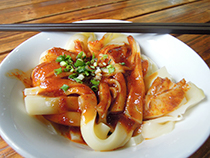 Some schools of thought claim that there is elegance to be found in simplicity. This no-frills bowl of noodles is a strong argument in favor of that philosophy. What we have in this dish are noodles made of rice bran coated with a thin chili sauce. The noodles are smooth and springy, curling playfully around each other inside the bowl. They are about a centimeter wide and half as thick, with squared edges because they are sliced off from a larger block. A ladleful of chili sauce coats the noodles without drowning them, adding a spicy jolt to the dish. This sauce is made of chili peppers, garlic, oil, ginger, and vinegar. Some vendors also incorporate Sichuanese peppercorns into the sauce, giving it more of a málà flavor. Other than the noodles and sauce, you might get a few pieces of lean meat, some green onions, or some pickled vegetables thrown in, but just as often the sauce and noodles will stand on their own. It’s a simple dish with great flavor, nice texture, and strong visual appeal. Less is definitely more in this case.
Some schools of thought claim that there is elegance to be found in simplicity. This no-frills bowl of noodles is a strong argument in favor of that philosophy. What we have in this dish are noodles made of rice bran coated with a thin chili sauce. The noodles are smooth and springy, curling playfully around each other inside the bowl. They are about a centimeter wide and half as thick, with squared edges because they are sliced off from a larger block. A ladleful of chili sauce coats the noodles without drowning them, adding a spicy jolt to the dish. This sauce is made of chili peppers, garlic, oil, ginger, and vinegar. Some vendors also incorporate Sichuanese peppercorns into the sauce, giving it more of a málà flavor. Other than the noodles and sauce, you might get a few pieces of lean meat, some green onions, or some pickled vegetables thrown in, but just as often the sauce and noodles will stand on their own. It’s a simple dish with great flavor, nice texture, and strong visual appeal. Less is definitely more in this case.
Key words: rice noodles, chili sauce, springy, spicy
豆花面
Dòu Huā Miàn
Cost: 8 RMB 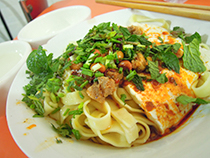 Zunyi’s dòu huā miàn is a great option for less adventurous eaters who still want to explore street food. Dòu huā – sometimes translated as “tofu pudding” – is basically a very soft tofu. In this dish, dòu huā is served with flat, fettuccine- shaped noodles, pork, mint leaves, chives, peanuts, and a bit of optional spicy sauce. Surprisingly, the end result tastes exactly like an Italian dish. Noodles? Red sauce? Mint? All Italian. Even the dòu huā tastes like ricotta cheese. The taste was so familiar to my Western palate that it almost didn't seem like Chinese food. So if you are the type that wants to try Chinese street food but you aren’t quite ready to dive into rabbit heads and pig brains, this may be the perfect place to start.
Zunyi’s dòu huā miàn is a great option for less adventurous eaters who still want to explore street food. Dòu huā – sometimes translated as “tofu pudding” – is basically a very soft tofu. In this dish, dòu huā is served with flat, fettuccine- shaped noodles, pork, mint leaves, chives, peanuts, and a bit of optional spicy sauce. Surprisingly, the end result tastes exactly like an Italian dish. Noodles? Red sauce? Mint? All Italian. Even the dòu huā tastes like ricotta cheese. The taste was so familiar to my Western palate that it almost didn't seem like Chinese food. So if you are the type that wants to try Chinese street food but you aren’t quite ready to dive into rabbit heads and pig brains, this may be the perfect place to start.
Key words: noodles, tofu, mint, pork
烙锅
Lào Guō
Cost: 15-30 RMB 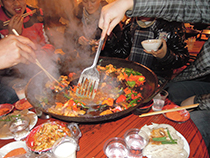 If you know a few things about Chinese food, you are probably familiar with hot pot. Different regions in China have their own ways of preparing hot pot, but few stray from the basic idea of using a large pot of broth to cook raw vegetables or meat right at your table. Unlike nearby cities like Chongqing and Chengdu, Zunyi does not have its own take on hot pot – what it does have is lào guō. Lào guō is not directly related to hot pot, but it does share similar characteristics. You might think of it as the stir fried version of hot pot. Instead of a pot full of broth, you have a wide, flat pan with an indented inner core designed to come in direct contact with the little stove. Just like hot pot, the ingredients are served raw. They can be anything from lotus roots to carrots to beef to fish. The ingredients are deposited a few at a time into the inner core, where they are stir fried in vegetable oil seasoned with red pepper (the oil is often considered the most important part, so individual vendors take their recipes very seriously). When the ingredients are suitably cooked, they are pulled from the core and left on the side of the pan, from which anybody at the table is welcome to help themselves. This is, of course, a communal dish, one well-suited to long meals full of conversations with old friends. While you eat, there is always more food hissing and popping in the pan, allowing meals to go on for as long as you like. Great street food with great friends – we should all be so lucky.
If you know a few things about Chinese food, you are probably familiar with hot pot. Different regions in China have their own ways of preparing hot pot, but few stray from the basic idea of using a large pot of broth to cook raw vegetables or meat right at your table. Unlike nearby cities like Chongqing and Chengdu, Zunyi does not have its own take on hot pot – what it does have is lào guō. Lào guō is not directly related to hot pot, but it does share similar characteristics. You might think of it as the stir fried version of hot pot. Instead of a pot full of broth, you have a wide, flat pan with an indented inner core designed to come in direct contact with the little stove. Just like hot pot, the ingredients are served raw. They can be anything from lotus roots to carrots to beef to fish. The ingredients are deposited a few at a time into the inner core, where they are stir fried in vegetable oil seasoned with red pepper (the oil is often considered the most important part, so individual vendors take their recipes very seriously). When the ingredients are suitably cooked, they are pulled from the core and left on the side of the pan, from which anybody at the table is welcome to help themselves. This is, of course, a communal dish, one well-suited to long meals full of conversations with old friends. While you eat, there is always more food hissing and popping in the pan, allowing meals to go on for as long as you like. Great street food with great friends – we should all be so lucky.
Key words: fried, special pan, spicy, meat, vegetables
March 17, 2019





